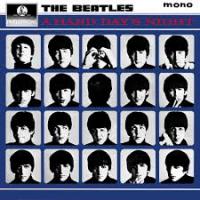"A Hard Day's Night" Mono Better Than Stereo?
On the other hand the mono buyers got a unique edition of "And I Love Her" where Paul's vocal isn't doubled. Early buyers got copies where "I'll Cry Instead" was listed as "I Cry Instead".
U.K. Beatles fans got a 14 song collection containing the seven movie songs on one side and six others written during the same incredibly busy and productive period of time. A Hard Day's Night was the first Beatles album with all songs written by the Lennon-McCartney songwriting team. John Lennon is the album's vocal star though Paul's "And I Love Her" is a stand out.
Annotator Tony Barrow writes about side two: "...it would have been a pity to cast aside such a fabulous set of songs solely because they couldn't be fitted into the structure of (the movie soundtrack)." That is true. Capitol released a few of the missing six tunes on Something New but omitted a few others while also including some but, of course, not all of the soundtrack tunes.
For Beatles fans it would have been a confusing period of time except that most were not aware of what was going on on "the other side of the pond" and had no idea that a label called Parlophone even existed or that their favorite albums had different covers, different titles and different tunes.
By this time Abbey Road had 4 track recorders and George Martin was able to produce better sounding records and definitely better sounding stereo records, though these were still produced by panning mono tracks and solidifying the mix with reverb as was and still is true of most "stereo" rock records.
The stereo digitally sourced reissue was among that box's best sounding records. Still, the mono mix has a lot going for it as well, especially an overall solidity and thrust that's diminished in stereo.
There's greater detail to be heard through this reissue compared to an original mono but that's not necessarily an advantage, especially on the double tracked vocals where you can far more clearly hear individually the separate tracks and hear where the singing is less than perfectly synched. On the other hand, useful musical details like the gorgeous strummed acoustic rhythm guitar on "And I Love Her", less obvious on the original, here shine.
Conversely, the double tracked sibilants sum up to greater than the individual parts and can be grating if you have to volume up too high or if your system begins with an edge. On the original mono these sibilants smear more smoothly together and so aren't as obvious. The smear hides the less than perfect vocal tracking. I found lowering the volume a bit solved that issue without diminishing the musical enjoyment or lessening the exposure of previously glossed over details. On balance I think the new reissue is superior in some ways to the original and perhaps not as good in others.
Overall, this is another successful mono reissue, the "analogy" nature of which should be immediately obvious to you, especially in how the reverb produces depth and naturally decays. It's slightly less fully fleshed out tonally compared to the original but it reveals far more detail as "detail" not as etchy brightness. The mono CD sounds good for a CD but lacks the vinyl's high frequency clarity and airiness, plus overall it sounds drab compared to the LP. But you knew that.
I was going to write that I prefer the stereo mix to the mono but I went back to the original to be sure. The stereo mix is tonally similar to the mono mix, which means it can be a bit spotlit on top but the added reverb produces a cushion that softens the blow. The reverb also diminishes the musical impact and after spending a few hours listening to the mono, the stereo sounds disjointed, subdued and surprisingly limp. I agree with Phil: "Back to Mono" Spector.
By the way, have you ever noticed John's odd harmonica swallow at the beginning of "I Should Have Known Better" where he seems to be sucking in and getting no sound? It's not in the mono mix. The stereo mix must have been cobbled together using the harmonica part from a different take. I bet he never bothered listening to the stereo mix because had he, I bet he would have nixed it.


